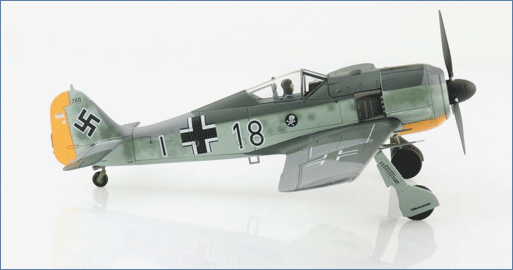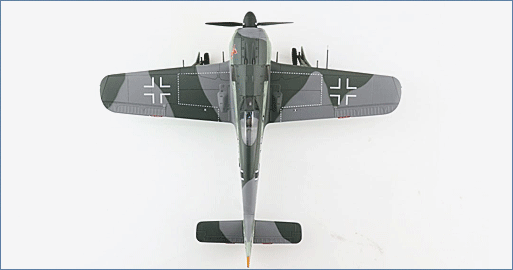Air Power Series>1:48 die-cast display model>FW-190>HA7428
FW 190A-4 Fw. R. Eisele, 8./JG 2, Brest-Guipavas, France, January 1943




General Background
In 1937 the Me-109 was an excellent aircraft but the Reich Air Ministry wanted a new advanced fighter that could out perform any future foreign designs. Kurt Tank’s Focke-Wulf Fw-190 Würger (Butcher Bird) won the design competition by using an air-cooled radial engine. When the Fw-190 entered combat in the summer of 1941 it already was Germany’s premiere piston-powered WWII fighter. Over 20,000 of all variants of the Fw-190 were built with 13,291 of these being of the 9 different “A” variants.
The Aircraft
Stab III was formed in 1940 and consisted of 7./JG2, 8./JG and 9./JG2. The Gruppenkommandeure from November 1, 1942 until July 1943 was Hptm Egon Mayer. 8./JG2 was located at Brest from April 1942 - 9 November 1942 and Brest-Guipavas from 22 November 1942 until approximately February 1943. 8./JG2 was tasked with the defense of western section of occupied France. The red wolf emblem of 8./JG2 was applied to left side cowling and the 8 victories Eisele scored up to January 1943 are marked on the rudder.
Specifications :
| Dimensions: | Wingspan – 10.5 m (34 ft 5 in) |
| Wing Area – 18.3 m (197 sq ft) | |
| Length – 8.96 m (29 ft 5 in) | |
| Height – 3.96 m (13 ft) | |
| Weight: | Empty – 3,470 kg (7,650 lb) |
| Maximum – 4,900 kg (10,800 lb) | |
| Performance: | Engine – BMW 801D 1,700 hp 14-cylinder radial engine |
| Maximum Speed – 657 kph (408 mph) (335 kts) | |
| Service Ceiling – 10,300 m (33,800 ft) | |
| Range – 800 km (500 mi) (435 nmi) | |
| Armament: | (2) 13 mm Machine Guns plus |
| (4) 20 mm cannon or | |
| (2) 20 mm cannons plus | |
| (2) 30 mm cannons |

